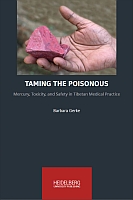Taming the Poisonous
Single-Blind-Peer-Review overseen by Series Editor
Mercury, Toxicity, and Safety in Tibetan Medical Practice
| dc.contributor.author | Gerke, Barbara | |
| dc.date.accessioned | 2021-06-21T13:37:15Z | |
| dc.date.available | 2021-06-21T13:37:15Z | |
| dc.date.issued | 2021 | |
| dc.identifier | ONIX_20210621_9783968220420_21 | |
| dc.identifier | ONIX_20210621_9783968220420_21 | |
| dc.identifier | OCN: 1291052357 | |
| dc.identifier.uri | https://library.oapen.org/handle/20.500.12657/49658 | |
| dc.description.abstract | This rich ethnographic and socio-historical account uncovers how toxicity and safety are expressed transculturally in a globalizing world. For the first time, it unpacks the “pharmaceutical nexus” of mercury in Tibetan medicine (Sowa Rigpa) where, since the thirteenth century, it has mainly been used in the form of tsotel. Tsotel, an organometallic mercury sulfide compound, is added in small amounts to specific medicines to enhance the potency of other ingredients. In concordance with tantric Buddhist ideas, Tibetan medical practitioners confront and tame poisonous substances, and instead of avoiding or expelling them, transform them into potent medicines and elixirs. Recently, the UN Environment Programme’s global ban on mercury, the Minamata Convention, has sparked debates on the use of mercury in Asian medicines. As Asian medical traditions increasingly intersect with biomedical science and technology, what is at stake when Tibetan medical practitioners in India and Nepal, researchers, and regulators negotiate mercury’s toxicity and safety? Who determines what is “toxic” and what is “safe,” and how? What does this mean for the future of traditional Asian medical and pharmaceutical practices? | |
| dc.language | English | |
| dc.relation.ispartofseries | Heidelberg Studies on Transculturality | |
| dc.subject.classification | thema EDItEUR::J Society and Social Sciences::JH Sociology and anthropology::JHM Anthropology::JHMC Social and cultural anthropology | en_US |
| dc.subject.other | Tibetan Medicine/Sowa Rigpa | |
| dc.subject.other | Mercury in Asian Medicine | |
| dc.subject.other | Medical Anthropology | |
| dc.subject.other | Mercury Toxicity | |
| dc.subject.other | Minamata Convention | |
| dc.subject.other | Tibetische Medizin/Sowa Rigpa | |
| dc.subject.other | Quecksilber in asiatischer Medizin | |
| dc.subject.other | Medizinische Anthropologie | |
| dc.subject.other | Quecksilbergiftigkeit | |
| dc.subject.other | Minamata-Übereinkommen | |
| dc.title | Taming the Poisonous | |
| dc.title.alternative | Mercury, Toxicity, and Safety in Tibetan Medical Practice | |
| dc.type | book | |
| oapen.abstract.otherlanguage | Diese umfassende ethnografische und sozio-historische Forschungsarbeit zeigt, wie verschiedene Sichtweisen von Toxizität und Sicherheit in einer globalisierenden Welt transkulturell zum Ausdruck kommen. Das Buch untersucht erstmalig den „pharmaceutical nexus“ von Quecksilber in der tibetischen Medizin (Sowa Rigpa). Dort wird es seit dem 13. Jahrhundert hauptsächlich in Form von tsotel, einer metallorganischen Quecksilbersulfidverbindung verwendet, welches in kleinen Mengen bestimmten Arzneimitteln zugesetzt wird, um die Wirksamkeit anderer Inhaltsstoffe zu verbessern. In Übereinstimmung mit tantrisch-buddhistischen Ideen setzen sich tibetische Ärzte mit giftigen Substanzen auseinander und verwandeln sie durch „Zähmung“ in wirksame Medikamente und Elixiere, anstatt sie zu vermeiden oder auszuleiten. Seit kurzem löst das vom Umweltprogramm der Vereinten Nationen initiierte weltweite Minamata-Übereinkommen Debatten über die Verwendung von Quecksilber in asiatischen Arzneimitteln aus. In diesem Zusammenhang interagieren asiatische Medizintraditionen zunehmend mit biomedizinischer Wissenschaft und Technologie. Dabei stellt sich die Frage, was auf dem Spiel steht, wenn tibetische Ärzte in Indien und Nepal, Forscher und Aufsichtsbehörden die Toxizität und Sicherheit von Quecksilber unterschiedlich definieren. Wer bestimmt, was „giftig“ und was „sicher“ ist, und wie? Was bedeutet dies für die Zukunft der traditionellen asiatischen medizinischen und pharmazeutischen Praxis? | |
| oapen.identifier.doi | 10.17885/heiup.746 | |
| oapen.relation.isPublishedBy | e783d080-4414-442b-9d7e-07b750c7b25d | |
| oapen.relation.isbn | 9783968220420 | |
| oapen.relation.isbn | 9783968220437 | |
| oapen.relation.isbn | 9783968220413 | |
| oapen.collection | AG Universitätsverlage | |
| oapen.series.number | 7 | |
| oapen.pages | 388 | |
| oapen.place.publication | Heidelberg | |
| peerreview.anonymity | Double-anonymised | |
| peerreview.id | e07c6bc8-0969-4c86-a485-6058c2347467 | |
| peerreview.open.review | No | |
| peerreview.publish.responsibility | Books or series editor | |
| peerreview.review.stage | Pre-publication | |
| peerreview.review.type | Full text | |
| peerreview.reviewer.type | External peer reviewer | |
| peerreview.title | Single-Blind-Peer-Review overseen by Series Editor |

